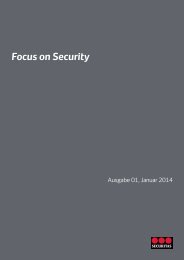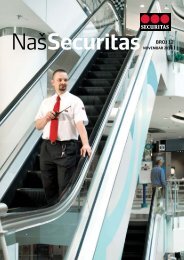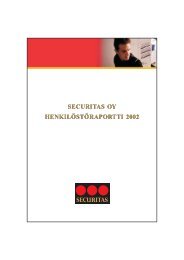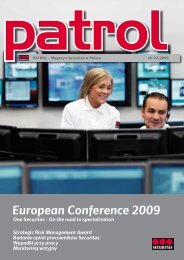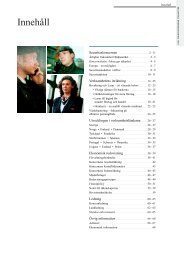SECURITAS AB Annual Report 2011
SECURITAS AB Annual Report 2011
SECURITAS AB Annual Report 2011
Create successful ePaper yourself
Turn your PDF publications into a flip-book with our unique Google optimized e-Paper software.
54 Governance and management<br />
Management and financial control<br />
Securitas’ financial model<br />
RELATIONSHIP BETWEEN INCOME, CASH FLOW AND BALANCE SHEET<br />
Statement of income<br />
The statement of income is broken down<br />
according to function, making responsibility for<br />
each profit level clear. Managers with operational<br />
responsibility can easily see what is expected of<br />
them and concentrate on the factors they can<br />
affect. Gross margin and operating margin are<br />
key indicators, and used in reviewing operations<br />
at both division and Group level. Amortization<br />
of acquisition-related intangible assets, acquisition-related<br />
costs, financial items and taxes is<br />
monitored separately.<br />
Total sales Operating income before amortization Operating non-current tangible and intangible assets<br />
Organic sales growth, % Investments in non-current tangible and intangible assets Accounts receivable<br />
Production expenses Reversal of depreciation Other operating capital employed<br />
Gross income<br />
Net investments in non-current tangible and<br />
intangible assets<br />
Gross margin, % Change in accounts receivable<br />
Branch office expenses Change in other operating capital employed<br />
Other selling and administrative expenses Cash flow from operating activities<br />
Operating income before amortization Net financial items paid<br />
Operating margin, % Current taxes paid<br />
Free cash flow<br />
Operating capital employed<br />
Acquisitions Shareholders Amortization of net debt<br />
This picture shows the connection between the statement of income, the statement of cash flow and the balance sheet. Different colors are used for the sake of clarity.<br />
n Operating items n Net-debt-related items n Goodwill, taxes and non-operating Items n Items related to shareholders’ equity<br />
FINANCIAL KEY FIGURES AND HOW WE USE THEM<br />
Securitas’ model focuses on the factors that<br />
impact profit, and are clearly linked to operations.<br />
Factors are grouped into categories: volumerelated<br />
factors, efficiency-related factors and<br />
capital-usage-related factors. These factors are<br />
then assigned key figures that are measured<br />
continuously, allowing managers to make decisions<br />
based on facts, enabling them to make<br />
quick adjustments if needed. The model is also<br />
used when analyzing acquisition targets.<br />
Securitas <strong>Annual</strong> <strong>Report</strong> <strong>2011</strong><br />
Statement of cash flow<br />
In principle, operating income should generate the<br />
same amount of cash flow from operating activities.<br />
The cash flow is affected by investments in,<br />
and depreciation of, non-current tangible and<br />
intangible assets used in operations and by changes<br />
in working capital. Cash flow from operating<br />
activities is an important indicator at operational<br />
level. It is defined as operating income less<br />
investments in non-current tangible and intangible<br />
assets plus reversal of depreciation, change in<br />
accounts receivable and change in other operating<br />
capital employed.<br />
Free cash flow is cash flow from operating<br />
activities less net financial items paid and current<br />
taxes paid. Cash flow for the year is arrived at<br />
when cash flow relating to acquisitions and share-<br />
holders’ equity is deducted from free cash flow.<br />
The consolidation of net debt in foreign currencies<br />
usually generates a translation difference that is<br />
reported separately. In addition, accounting stan-<br />
The factors and key figures are used throughout<br />
our operations from branch level up to Group<br />
level. Six key figures represent the backbone of<br />
the model (highlighted in the text and table), but<br />
there are complementary key figures used by<br />
all divisions, such as organic sales growth and<br />
operating margin. There are also complementary<br />
key figures tailored to the measurement needs<br />
of a particular division. In Security Services North<br />
America, Security Services Europe and Security<br />
dards require that certain elements of the net<br />
debt are revalued to market value after the initial<br />
recognition and this revaluation is also reported<br />
separately. The change in net debt corresponds<br />
to cash flow for the year plus the change in loans,<br />
translation differences and also the revaluation of<br />
financial instruments.<br />
Balance sheet<br />
Securitas uses the terms “capital employed” and<br />
“financing of capital employed” to describe the<br />
balance sheet and financial position. Capital<br />
employed consists of operating capital employed<br />
plus goodwill, acquisition-related intangible assets<br />
and shares in associated companies.<br />
Operating capital employed, which consists<br />
of operating non-current tangible and intangible<br />
assets and working capital, is continuously monitored<br />
at the operating level to avoid unnecessary<br />
tied-up capital. Capital employed is financed by<br />
net debt and shareholders’ equity.<br />
Services Ibero-America, which offer specialized<br />
security services to large and medium-sized<br />
customers, gross margin on new sales and on<br />
terminations as well as the wage cost increase<br />
are particularly important key figures. For Mobile<br />
and Monitoring, new / cancelled connections,<br />
prospects visited, cost per sale / order, average<br />
contract size and payback / duration are the key<br />
figures that are monitored closely.





